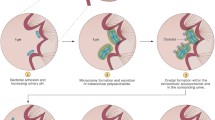Abstract
The presence of infectious microorganisms in urinary stones is commonly inferred from stone composition, especially by the presence of struvite in a stone. The presence of highly carbonated apatite has also been proposed as a marker of the presence of bacteria within a stone. We retrospectively studied 368 patients who had undergone percutaneous nephrolithotomy (PCNL), and who also had culture results for both stone and urine. Urine culture showed no association with stone mineral content, but stone culture was more often positive in struvite-containing stones (73 % positive) and majority apatite stones (65 %) than in other stone types (54 %, lower than the others, P < 0.02). In 51 patients in whom the carbonate content of apatite could be measured, carbonate in the apatite was weakly predictive of positive stone culture with an optimal cutoff value of 13.5 % carbonate (sensitivity 0.61, specificity 0.80). In positive cultures of stones (all mineral types combined), organisms that characteristically produce urease were present in 71 % of the cases, with no difference in this proportion among different types of stone. In summary, the type of mineral in the stone was predictive of positive stone culture, but this correlation is imperfect, as over half of non-struvite, non-apatite stones were found to harbor culturable organisms. We conclude that mineral type is an inadequate predictor of whether a stone contains infectious organisms, and that stone culture is more likely to provide information useful to the management of patients undergoing PCNL.


Similar content being viewed by others
References
Miano R, Germani S, Vespasiani G (2007) Stones and urinary tract infections. Urol Int 79:32–36
Rieu P (2005) Lithiases d’infection. Ann Urol (Paris) 39:16–29
Abrahams HM, Stoller ML (2003) Infection and urinary stones. Curr Opin Urol 13:63–67
Griffith DP, Osborne CA (1987) Infection (urease) stones. Miner Electrol Metab 13:278–285
Griffith DP (1978) Struvite stones. Kidney Int 13:372–382
Thomas B, Tolley D (2008) Concurrent urinary tract infection and stone disease: pathogenesis, diagnosis and management. Nat Clin Pract Urol 5:668–675
Miller NL, Lingeman JE (2007) Management of kidney stones. BMJ 334:468–472
Margel D, Ehrlich Y, Brown N, Lask D, Livne PM, Lifshitz DA (2006) Clinical implication of routine stone culture in percutaneous nephrolithotomy—a prospective study. Urology 67:26–29
Preminger GM, Assimos DG, Lingeman JE, Nakada SY, Pearle MS, Wolf JS (2005) Chapter 1: AUA guideline on management of staghorn calculi: Diagnosis and treatment recommendations. J Urol 173:1991–2000
Gonen M, Turan H, Ozturk B, Ozkardes H (2008) Factors affecting fever following percutaneous nephrolithotomy: a prospective clinical study. J Endourol 22:2135–2138
Cadeddu JA, Chen R, Bishoff J, Micali S, Kumar A, Moore RG, Kavoussi LR (1998) Clinical significance of fever after percutaneous nephrolithotomy. Urology 52:48–50
Griffith DP (1982) Infection-induced renal calculi. Kidney Int 21:422–430
Hugosson J, Grenabo L, Hedelin H, Pettersson S, Seeberg S (1990) Bacteriology of upper urinary tract stones. J Urol 143:965–968
Bazin D, André G, Weil R, Matzen G, Emmanuel V, Carpentier X, Daudon M (2012) Absence of bacterial imprints on struvite-containing kidney stones: a structural investigation at the mesoscopic and atomic scale. Urology 79:786–790
Carpentier X, Daudon M, Traxer O, Jungers P, Mazouyes A, Matzen G, Vèron E, Bazin D (2009) Relationships between carbonation rate of carbapatite and morphologic characteristics of calcium phosphate stones and etiology. Urology 73:968–975
Griffith DP, Klein AS (1983) Infection-induced urinary stones. In: Roth RA, Finlayson B (eds) Stones: clinical management of urolithiasis. Williams & Wilkins, Baltimore
Pramanik R, Asplin JR, Jackson ME, Williams JC Jr (2008) Protein content of human apatite and brushite kidney stones: significant correlation with morphologic measures. Urol Res 36:251–258
Maurice-Estepa L, Levillain P, Lacour B, Daudon M (1999) Crystalline phase differentiation in urinary calcium phosphate and magnesium phosphate calculi. Scand J Urol Nephrol 33:299–305
Williams JC Jr, Mcateer JA, Evan AP, Lingeman JE (2010) Micro-computed tomography for analysis of urinary calculi. Urol Res 38:477–484
Krambeck AE, Khan NF, Jackson ME, Lingeman JE, Mcateer JA, Williams JC Jr (2010) Inaccurate reporting of mineral composition by commercial stone analysis laboratories: implications for infection and metabolic stones. J Urol 184:1543–1549
Hesse A, Sanders G (1988) Atlas of infrared spectra for the analysis of urinary concrements. Georg Thieme Verlag, Stuttgart
Korets R, Graversen JA, Kates M, Mues AC, Gupta M (2011) Post-percutaneous nephrolithotomy systemic inflammatory response: a prospective analysis of preoperative urine, renal pelvic urine and stone cultures. J Urol 186:1899–1903
Mariappan P, Smith G, Bariol SV, Moussa SA, Tolley DA (2005) Stone and pelvic urine culture and sensitivity are better than bladder urine as predictors of urosepsis following percutaneous nephrolithotomy: a prospective clinical study. J Urol 173:1610–1614
Draga RO, Kok ET, Sorel MR, Bosch RJ, Lock TM (2009) Percutaneous nephrolithotomy: factors associated with fever after the first postoperative day and systemic inflammatory response syndrome. J Endourol 23:921–927
Hesse A, Heimbach D (1999) Causes of phosphate stone formation and the importance of metaphylaxis by urinary acidification: a review. World J Urol 17:308–315
Nancollas GH (1989) In vitro studies of calcium phosphate crystallization. In: Mann S, Webb J, Williams RJP (eds) Biomineralization. Chemical and biochemical perspectives. VCH Verlagsgesellschaft, Weinheim
Fowler JE Jr (1984) Bacteriology of branched renal calculi and accompanying urinary tract infection. J Urol 131:213–215
Wandt M, Rodgers A (1988) Quantitative X-ray diffraction analysis of urinary calculi by use of the internal-standard method and reference intensity ratios. Clin Chem 34:289–293
Kasidas GP, Samuell CT, Weir TB (2004) Renal stone analysis: why and how? Ann Clin Biochem 41:91–97
Acknowledgments
We thank Molly Jackson for excellent technical work on this project, and Leslie Pillow for help in studying the apatite morphologies. This work was funded by NIH R01 DK059933.
Conflict of interest
The authors declare that they have no conflict of interest.
Author information
Authors and Affiliations
Corresponding author
Rights and permissions
About this article
Cite this article
Englert, K.M., McAteer, J.A., Lingeman, J.E. et al. High carbonate level of apatite in kidney stones implies infection, but is it predictive?. Urolithiasis 41, 389–394 (2013). https://doi.org/10.1007/s00240-013-0591-6
Received:
Accepted:
Published:
Issue Date:
DOI: https://doi.org/10.1007/s00240-013-0591-6




